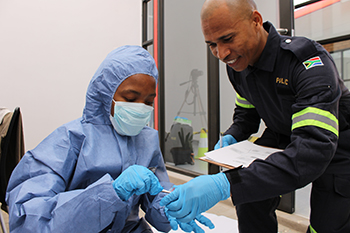
Ntau Mafisa, a forensic science honours student
at the UFS, and Captain Samuel Sethunya from
the SAPS Crime Scene Management in
Bloemfontein.
Photo: Leonie Bolleurs
With murder and robbery rates on the rise, the Forensic Science Programme of the Department of Genetics at the University of the Free State is playing a key role in training South Africa’s future crime scene investigators and forensic laboratory analysts.
According to the Institute for Security Studies (ISS), murder and aggravated robbery rates for 2014/2015, as recorded by the South African Police Services (SAPS) have increased. Incidents of murder increased by 4.6% in the period from 2013/2014 to 2014/2015 and aggravated robbery increased by 8.5 % in the same period. The ISS is an African organisation thant enhances human security by providing independent and authoritative research, expert policy advice and capacity building.
Dr Ellen Mwenesongole, a forensic science lecturer at the Department of Genetics, said the university was one of a few universities in South Africa that actually had a forensic science programme, especially starting from undergraduate level.
Crime scene evaluation component incorporated in curriculum
As part of its Forensic Science Honours Programme, the department has, for the first time, incorporated a mock crime scene evaluation component in its curriculum. Students process a mock crime scene and are assessed based on how closely they follow standard operating procedures related to crime scenes and subsequent laboratory analysis of items of possible evidential value.
The mock crime scene forms part of a research project data collection of the honours students. In these projects students utilise different analytical methods to analyse and distinguish between different types of evidence such as hair fibres, cigarette butts, illicit drugs and dyes extracted from questioned documents and lipsticks.
Students utilise different analytical methods to analyse
and distinguish between different types of evidence.
This year, the department trained the first group of nine students in the Forensic Science Honours Programme. Dr Mwenesongole, who received her training in the UK at the University of Strathclyde in Glasgow, Scotland, and Anglia Ruskin University in Cambridge, England, said incorporating a crime scene evaluation component into the curriculum was a global trend at universities that were offering forensic science programmes.
Department of Genetics and SAPS collaborate
It is important to add this component to the student’s curriculum. In this way the university is equipping students not only with theoretical knowledge but practical knowledge on the importance of following proper protocol when collecting evidence at crime scenes and analysing it in the laboratory to reduce the risk of it becoming inadmissible in a court of law.
The Genetics Department has a good working relationship with the Forensic Science Laboratory and Free State Crime Scene Management of the Division Forensic Services of the SAPS. The mock crime scene was set up and assessed in collaboration with the Crime Scene Management Division of the SAPS. Although the SAPS provides specialist advanced training to its staff members, the university hopes to improve employability for students through such programmes.